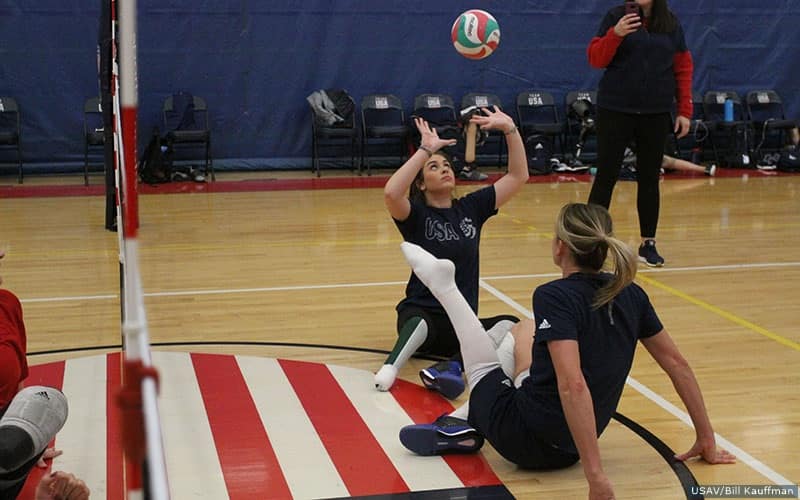
COLORADO SPRINGS, Colo. (Jan. 23, 2019) – The U.S. Women’s National Sitting Volleyball Team is not resting on its laurels earned over the past decade. Gold at the 2016 Paralympic Games after winning silver the previous two editions and three consecutive silvers at World ParaVolley World Championships has the team hungry for more.
To raise the bar, the U.S. switched things up for its first full training block since finishing second at the 2018 World Championships. The team, which normally trains at the University of Central Oklahoma in Edmond, held its first full team session of 2019 last week at the U.S. Olympic Training Center in Colorado Springs with a few goals in mind. The five-day training block at the Olympic Training Center allowed the staff to mix in sessions beyond just training on the court.
“Our main goal was to come (to Colorado Springs) and have Elite Athlete Health Profiles done,” said Bill Hamiter, head coach for the U.S. Women’s Sitting Team. “The Sports Medicine department at the OTC works with the athletes that are in the system, doing a lot of different screenings.”
Hamiter said the health profiles are essential for the long-term health of the athletes and program. “We can look for any weaknesses that there might be so that we can make those adjustments between now and the Paralympic Games since we are already qualified. It gives us about a year and a half to really work on a lot of those types of things so the ladies can make adjustments.”
While the team holds training blocks one weekend a month plus a handful of athletes training weekdays as part of the resident program in Oklahoma, the team is now just getting back together since winning silver at World Championships.
“We train year-round,” Hamiter said. “Like everyone, they needed time off, and they had about two, two-and-half months off. Some of our resident athletes have been on the floor for about two weeks. For everybody else, it has been a little more of a challenge. Getting the whole team back together, it is difficult with timing and their rhythm not quite the same as when they are practicing all the time. The mental aspect, the reading aspect – those are bigger challenges. It slows down some as you are not on that competitive edge. But early on for us, that is what we work to do. Get them back in the groove and really work on our skill training, get them on the learning processes and back in gear so next month we will raise that bar a little bit higher, execute at a higher level and kick it in as we start to compete.”
Hamiter was impressed with how the younger athletes blended together with the veterans in Colorado Springs, even after a long break from training.
“For a lot of our newer athletes we are always trying to push them to gain as much as they possibly can,” Hamiter said. “We keep seeing good things from those younger, newer athletes. Sydney (Satchell), Annie (Flood), Jillian (Williams) and Emma (Schieck) – every time they get on the court, we see a little more progress. It is really nice to see that. For the whole group, over the course of time we were here it was great to see them getting in a better rhythm and raise their level of play.”
Setter Kaleo Maclay, who has two Paralympic Games under her belt, felt the young players have helped the team progress – much like she did when she joined the program at age 12.
“Always having new players is exciting and good for the whole team,” Maclay said. “Bringing in new players helps us re-adjust to things that we have gotten used to on the court and to get to see new players come and really show what they have and how good they have gotten.”
By exposing the team to the Olympic Training Center, the women were able to draw from the Olympic spirit and see the bigger picture.
“For us, the ladies really enjoyed the trip here,” Hamiter said. “Some of it is because of the movement – it is the Olympic and Paralympic Training Center. Coming in with that in mind and seeing other athletes here is a whole cultural perspective that our athletes can tie into, which I think is nice.”
“The training site has a lot of facilities that we don’t’ typically have in Oklahoma,” setter Kaleo Maclay said. “So we got to test and figure out our body composition and how we can improve our training at home (In Oklahoma).”
Along with the intense court training sessions and in-depth health screenings, the U.S. Women were able to use other resources available to them while in Colorado Springs. The athletes were exposed to nutritionists, financial planning through USA Volleyball, career education through the USOC and SafeSport education.
U.S. Women’s National Sitting Team Athletes at January Training Block in Colorado Springs
Name (Position, Height, Hometown)
Monique Burkland (OH, 5-9, Ardmore, Oklahoma)
Whitney Dosty (OH, 6-3, Tucson, Arizona)
Tia Edwards (OH, 5-7, Skitatook, Oklahoma)
Heather Erickson (OH, 5-11, Fayetteville, North Carolina)
Annie Flood (S/OPP, 5-7, Salem, Oregon)
Katie Holloway (OH, 6-3, Lake Stevens, Washington)
Kaleo Kanahele Maclay (S, 5-6, Edmond, Oklahoma)
Nicky Nieves (MB, 5-10, Kissimmee, Florida)
Sydney Satchell (L, 5-1, Oklahoma City, Oklahoma)
Emma Schieck (OH, 5-7, Statesville, North Carolina)
Lexi Shifflett (S, 5-4, Waseca, Minnesota)
Lora Webster (MB, 5-11, Point Lookout, New York)
Jillian Williams (OPP, 5-10, Odem, Texas)
Athletes Unable to Attend Training Block
Courtney Baker (OH, 5-9, Crofton, Kentucky)
Nichole Millage (OH, 5-7, Champaign, Illinois)
Bethany Zummo (L, 5-2, Dublin, California)
